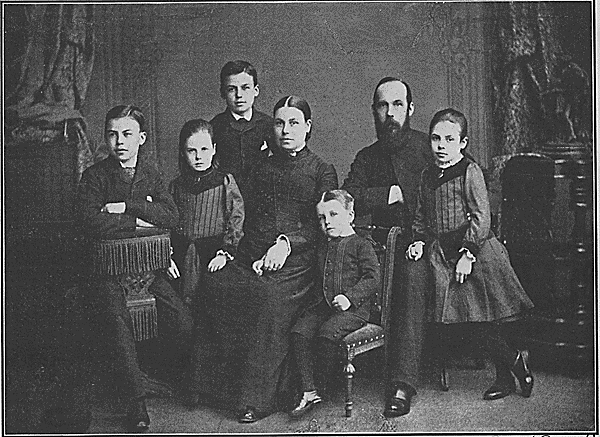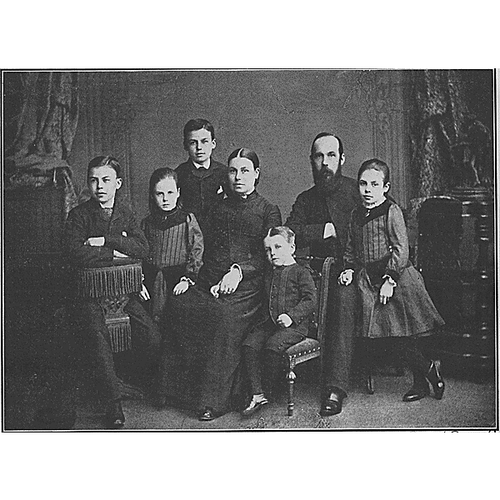
Source: Courtesy of Wikimedia Commons
COLLISON, WILLIAM HENRY, Church of England missionary and clergyman; b. 12 Nov. 1847 in County Armagh (Northern Ireland), son of John J. Collison and Mary Emily Maxwell; m. 19 Aug. 1873 Marion M. Goodwin (d. 1919), and they had five sons and three daughters; d. 21 Jan. 1922 in Kincolith (Gingolx), B.C.
Educated at the Church of Ireland Training College in Dublin, William Henry Collison began his career as a schoolmaster in charge of an industrial school at Cork. In November 1872 he read of the Church Missionary Society’s need for recruits, and determined to apply. The following April he entered the Church Missionary College in Islington (London) for a brief period of training. The CMS decided that his qualifications made him a suitable assistant for William Duncan*, the lay missionary in charge of the North Pacific mission, centred at Metlakatla, B.C. The society, which had difficulty in placing ordained missionaries there, opted to send Collison out as a layman with a view to his later ordination, and gave him permission to marry before leaving. His wife, Marion Goodwin, was well prepared for the mission field: she was a deaconess and a trained nurse who had served in the Franco-German War and during a smallpox epidemic in Cork.
The Collisons arrived in Victoria on 25 Oct. 1873. They were met by Edward Cridge, the dean of Christ Church Cathedral, with whom they resided before leaving for Metlakatla in early November. Cridge was engaged in a bitter dispute with George Hills*, the bishop of British Columbia. By staying with Cridge and failing to present his credentials to Hills, Collison became embroiled in the factional politics of the diocese.
At Metlakatla, his first task was to learn the Tsimshian language. By the following summer he could conduct the greater part of church services without an interpreter. As well as preaching, his duties included visiting and teaching, and initially he was confident of success. However, the mission was in a state of tension. Duncan and Cridge, who shared a commitment to low-church evangelicalism, were friends, and consequently the Hills-Cridge dispute disordered relations between Duncan and Hills. Given Duncan’s increasing hostility to ecclesiastical authority, Collison’s ordination was put off. Earnest and not particularly anxious for promotion, he persevered in his missionary duties, while managing to retain Duncan’s confidence. He became interested in the Haida when a group from Masset, on the Queen Charlotte Islands, visited Fort Simpson (Lax Kw’alaams) in 1874 and 1875. During these visits he began to evangelize Chief Seegay, whose half-Tsimshian wife acted as translator. In June 1876 Collison was begged to minister to Seegay since he was dying of tuberculosis. Collison made the voyage to Masset, and on his return obtained permission to open a mission there. After the Collisons’ move in November, William expanded his knowledge of Haida, eventually translating portions of the Bible and the Book of Common Prayer and composing hymns in this language.
While the Collisons were at Masset, Duncan and Hills’s relationship deteriorated, and Hills asked the CMS to send Bishop William Carpenter Bompas* of Athabasca to intervene. He arrived at Metlakatla in November 1877 and spent the winter. The following March at Kincolith, a CMS mission among the Niska (Nisga’a) at the mouth of the Nass River, Collison was ordained deacon and priest by Bompas, who also negotiated a redistribution of duties, assigning Duncan the secular affairs of Metlakatla and Collison the “spiritual charge” of Metlakatla, Kincolith, and the Queen Charlottes. Reluctantly, Collison left the Haida mission in 1879 and returned to Metlakatla, where he soon encountered more conflict. William Ridley, who had arrived with the support of the CMS to take up duties as bishop of the newly formed diocese of Caledonia, had quickly run foul of Duncan, who prohibited Communion and confirmation and resisted translation work. From London the society wrote Collison letters of encouragement that acknowledged his difficult position, and urged him to maintain calm in the face of factionalism and sporadic violence. In 1882, after Ridley had formally removed Duncan from connection with the CMS, the situation became so tense that Collison was compelled to leave Metlakatla for a time. Collison asked to be sent to another mission, and in May 1884 he and his family moved to Kincolith. He learned more Niska, and soon translated the services of Morning and Evening prayer. Marion Collison’s role was equally significant. Like other missionary wives, she was responsible for teaching European domestic skills to the native women, and for modelling appropriate female behaviour. As a nurse, she helped avert a smallpox epidemic. Collison regarded her medical contributions as central to his work: “Her skill in ministering to the sick, and in dressing the wounds of those injured, tended in no small degree to bring them under the influence of the teaching of the Gospel of Salvation.”
In 1891 Collison, whose support of Ridley and the CMS was unwavering, was unanimously selected as the diocese’s first archdeacon. A serious blow came in September 1893 when the church at Kincolith and three-quarters of the village were destroyed by fire. Shortly after rebuilding had begun, a fervent spiritual revival threatened to undermine the stability of the community. In response, Collison introduced a native branch of the Church Army, a strongly evangelical Anglican organization that emphasized enthusiastic worship, and promoted native leadership within the church-sponsored society.
When Ridley resigned as bishop in 1904, Collison declined to be nominated to the episcopacy, choosing to remain at Kincolith. At his death there in 1922 he was the longest serving CMS missionary in the North British Columbia mission (as North Pacific had been renamed) and he was the only remaining missionary funded directly by the CMS. His letters to the society and his autobiography, In the wake of the war canoe, reveal a moderate and conscientious man who strove to maintain “the best interests of the mission” in the face of schism. Despite Duncan’s blatant failure at times to recognize his contributions, Collison was remarkably reticent in his autobiography about the difficulties at Metlakatla. He was noted for his warmth, generosity, and hospitality, and for his commitment to his work.
Collison’s interaction with the native peoples was complex. He respected the converts, became fluent in Tsimshian, Haida, and Niska, and was sensitive to the importance of the clan system. (According to his son William Edwin, also an ordained missionary, he had been adopted into the Eagle clan of the Haida.) On the other hand, he fiercely opposed potlatching and traditional native medicine, and encouraged the Niska at Kincolith to accept the Indian Advancement Act of 1884, which replaced traditional hierarchies of power with a system of elected chiefs and band councils supervised by an Indian agent. Perhaps these contradictions can best be explained by Collison’s own theory of missions, with its implication that the missionary was the best judge of what was appropriate for his converts: “It is incumbent on the missionary to welcome and foster whatever tends to the uplifting and improvement of the people amongst whom he labours, whilst carefully guarding against whatever tends to degrade or defeat his mission.”
[William Henry Collison’s autobiography, In the wake of the war canoe . . . (London, 1915), appeared in an identical edition in Toronto the following year. An abridged version, edited and annotated by Charles Lillard, was published in Victoria in 1981, but it omits many of the details of Collison’s missionary activities. None of Collison’s Haida translations seem to have been printed, although they may have formed the basis of the later translation work by the Reverend Charles Harrison, CMS missionary at Masset in 1882–90, published by the Society for Promoting Christian Knowledge and the British and Foreign Bible Society. g. e.]
Two letters by Collison appear in the Church Missionary Intelligencer and Record (London): “First letter from Queen Charlotte’s Islands,” [3rd] ser., 2 (1877): 374–77, and “News from Queen Charlotte’s Islands,” [3rd] ser., 3 (1878): 516–18. Reports by Collison, Duncan, and other British Columbia missionaries were published there as “North Pacific Mission,” [3rd] ser., 4 (1879): 557–66. LAC, MG 17, B2, C, C.1/M.9-M.10; C.2/O; G, C.1/P.3; C.2/L; C.2/O (mfm.). Daily Colonist (Victoria), 24 Jan. 1922. Alexander Anderson, “An official view of Metlakahtla,” Church Missionary Intelligencer and Record, [3rd] ser., 6 (1881): 50–52. “Bishop Ridley and the North Pacific Mission,” Church Missionary Intelligencer and Record, [3rd] ser., 9 (1884): 165–67. Church Missionary Soc., Report of the deputation to Metlakatla: (General Touch and the Rev. W. R. Blackett) ([London, 1886]). [Edward Cridge and W. J. Macdonald], The Church and the Indians: the trouble at Metlakahtla ([Victoria, 1882]). F. [H.] DuVernet, “Hagwilyaen, Shimoigit,” Across the Rockies (London), 13 (1922), no.2: 23–24. “The government commission at Metlakahtla,” Church Missionary Intelligencer and Record, [3rd] ser., 10 (1885): 340–54. Hugh McCullum and Karmel Taylor McCullum, Caledonia 100 years ahead (Toronto, 1979). Peter Murray, The devil and Mr. Duncan (Victoria, 1985). E. P. Patterson, Mission on the Nass: the evangelization of the Nishga (1860–1890) (Waterloo, Ont., 1982). F. A. Peake, The Anglican Church in British Columbia (Vancouver, 1959). [William Ridley], Senator Macdonald’s misleading account of his visit to Metlakatla exposed ([Victoria], 1882). E. O. S. Scholefield and F. W. Howay, British Columbia from the earliest times to the present (4v., Vancouver, 1914), 4: 1369–70. Eugene Stock, The history of the Church Missionary Society, its environment, its men and its work (4v., London, 1899–1916). Jean Usher [Friesen], William Duncan of Metlakatla: a Victorian missionary in British Columbia (Ottawa, 1974).
Cite This Article
Gail Edwards, “COLLISON, WILLIAM HENRY,” in Dictionary of Canadian Biography, vol. 15, University of Toronto/Université Laval, 2003–, accessed December 12, 2025, https://www.biographi.ca/en/bio/collison_william_henry_15E.html.
The citation above shows the format for footnotes and endnotes according to the Chicago manual of style (16th edition). Information to be used in other citation formats:
| Permalink: | https://www.biographi.ca/en/bio/collison_william_henry_15E.html |
| Author of Article: | Gail Edwards |
| Title of Article: | COLLISON, WILLIAM HENRY |
| Publication Name: | Dictionary of Canadian Biography, vol. 15 |
| Publisher: | University of Toronto/Université Laval |
| Year of publication: | 2005 |
| Year of revision: | 2005 |
| Access Date: | December 12, 2025 |



